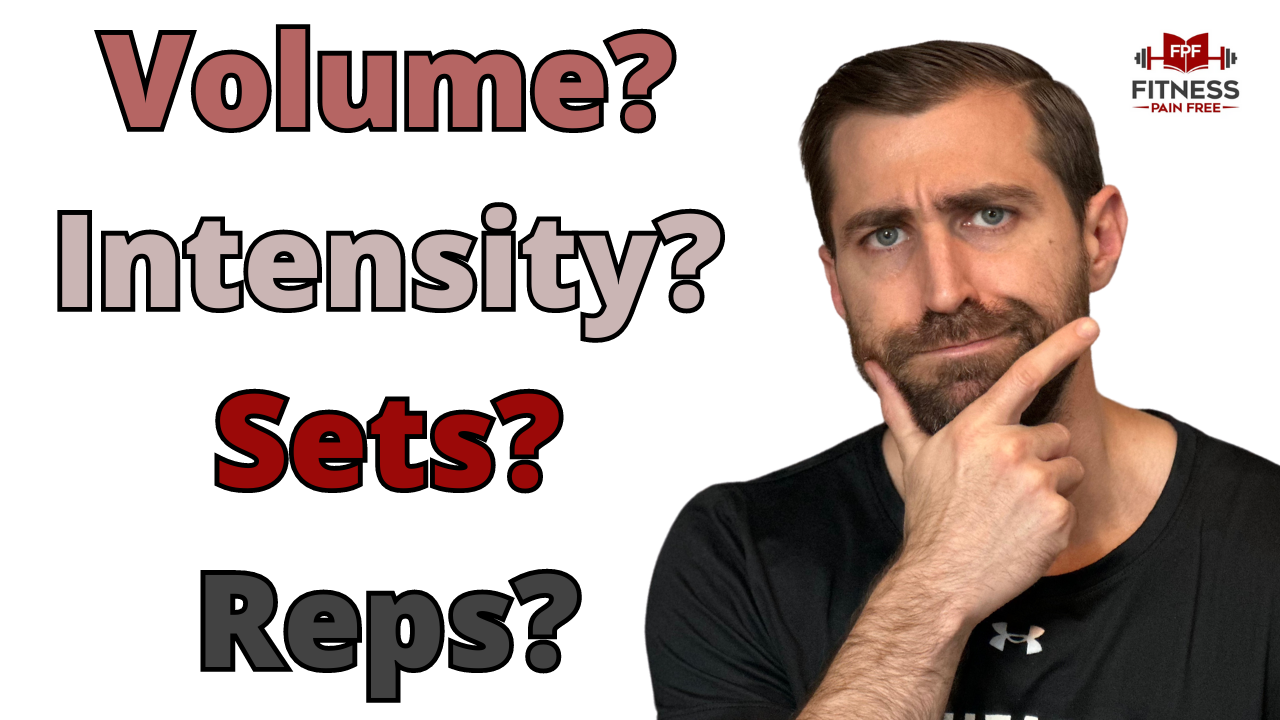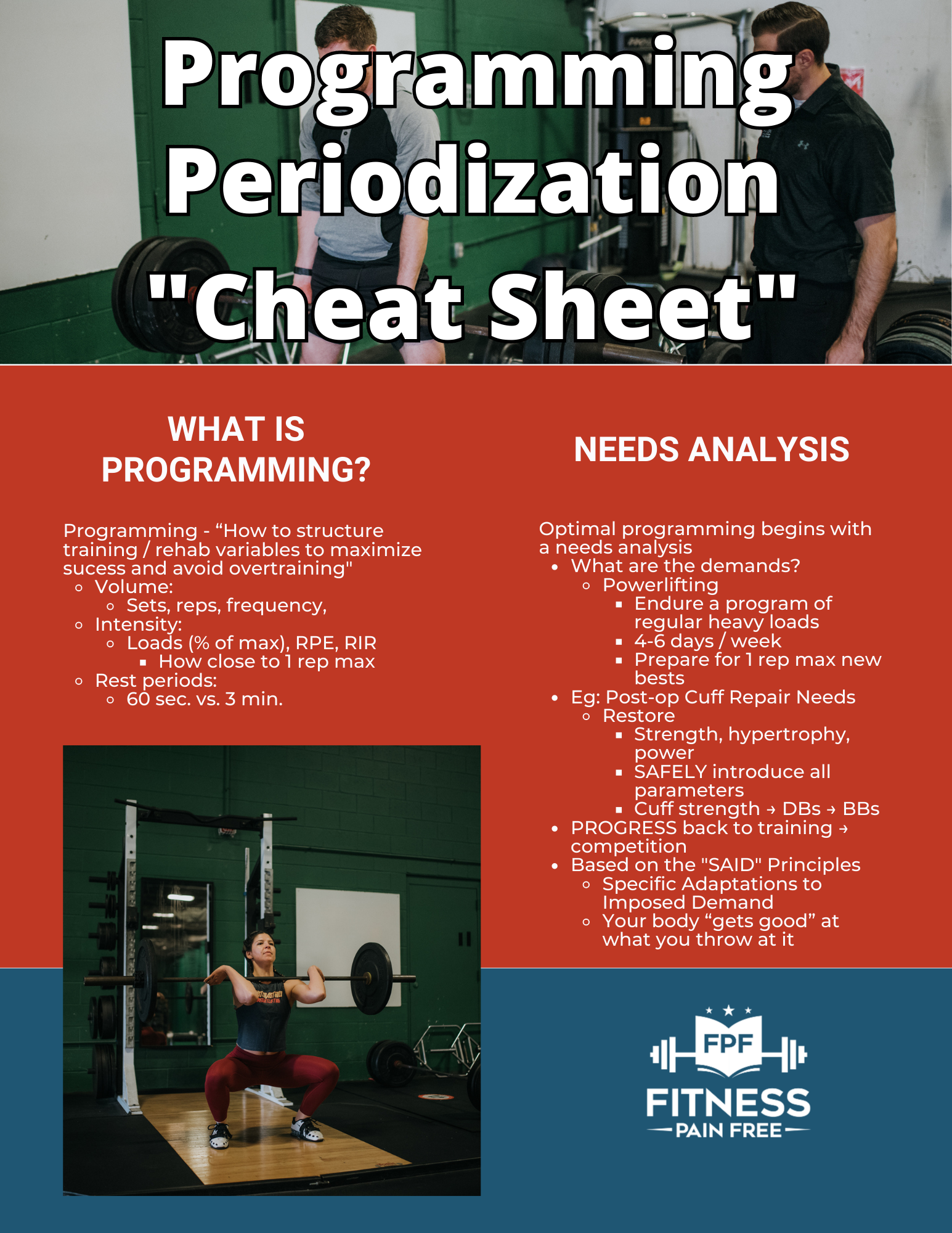
Programming and Periodization MASTER CLASS for Physical Therapists
To go along with today's video I have a nice infographic to share...
Programming and Periodization "Cheat Sheet" for Clinicians
Click HERE to download it for FREE:
Click HERE to Download FREE
Grab the rest of the Mini Course and Sign up for the Certification Pre-sale list:
- FPF Mini Course - 7 Reasons Why Injuries Happen in the Gym and What to do About it
- The Fitness Pain Free Certification
In today's episode we go over Programming and Periodization MASTER CLASS for Physical Therapists:
Welcome coaches and clinicians to another video!
I'm always asking physical therapy students what they feel like they need the most to succeed in a sports physical therapy / strength and conditioning environment and one of the top answers is usually programming and periodization.
This is generally a topic not covered in school but very important for improving your patient's outcomes. In today's video I do my best to simplify and educate folks on the topic of programming and periodization. We go over:
This is part 4 of our 4 part series. If you missed part 1, 2 and 3 then go check it out in the "show notes / relevant articles" section below. Enjoy!
Best programming out there...
- Dan Pope DPT,OCS,CSCS
Want to support me and decide topics for future episodes? Click HERE to sign up for FPF "Insiders" for just a dollar. You'll gain access to 100+ webinars, e-books and complete guides. Plus, you'll get private access to the "Insiders" Facebook group where you can have all of your questions answered by me.
Looking for other ways to support me that are 100% free?
- Like, comment and share on youtube, facebook and instagram
- Leave a 5-star review on apple podcasts
Thank you!
Dan Pope DPT, OCS, CSCS
References:
Krzysztofik M, Wilk M, Wojdała G, Gołaś A. Maximizing Muscle Hypertrophy: A Systematic Review of Advanced Resistance Training Techniques and Methods. Int J Environ Res Public Health. 2019 Dec 4;16(24):4897. doi: 10.3390/ijerph16244897. PMID: 31817252; PMCID: PMC6950543.
Williams TD, Tolusso DV, Fedewa MV, Esco MR. Comparison of Periodized and Non-Periodized Resistance Training on Maximal Strength: A Meta-Analysis. Sports Med. 2017 Oct;47(10):2083-2100. doi: 10.1007/s40279-017-0734-y. PMID: 28497285.
Moesgaard L, Beck MM, Christiansen L, Aagaard P, Lundbye-Jensen J. Effects of Periodization on Strength and Muscle Hypertrophy in Volume-Equated Resistance Training Programs: A Systematic Review and Meta-analysis. Sports Med. 2022 Jul;52(7):1647-1666. doi: 10.1007/s40279-021-01636-1. Epub 2022 Jan 19. PMID: 35044672.
Schoenfeld BJ, Grgic J, Van Every DW, Plotkin DL. Loading Recommendations for Muscle Strength, Hypertrophy, and Local Endurance: A Re-Examination of the Repetition Continuum. Sports (Basel). 2021 Feb 22;9(2):32. doi: 10.3390/sports9020032. PMID: 33671664; PMCID: PMC7927075.
Schoenfeld BJ, Pope ZK, Benik FM, Hester GM, Sellers J, Nooner JL, Schnaiter JA, Bond-Williams KE, Carter AS, Ross CL, Just BL, Henselmans M, Krieger JW. Longer Interset Rest Periods Enhance Muscle Strength and Hypertrophy in Resistance-Trained Men. J Strength Cond Res. 2016 Jul;30(7):1805-12. doi: 10.1519/JSC.0000000000001272. PMID: 26605807.
Nunes JP, Grgic J, Cunha PM, Ribeiro AS, Schoenfeld BJ, de Salles BF, Cyrino ES. What influence does resistance exercise order have on muscular strength gains and muscle hypertrophy? A systematic review and meta-analysis. Eur J Sport Sci. 2021 Feb;21(2):149-157. doi: 10.1080/17461391.2020.1733672. Epub 2020 Feb 28. PMID: 32077380.
Schoenfeld BJ, Grgic J, Krieger J. How many times per week should a muscle be trained to maximize muscle hypertrophy? A systematic review and meta-analysis of studies examining the effects of resistance training frequency. J Sports Sci. 2019 Jun;37(11):1286-1295. doi: 10.1080/02640414.2018.1555906. Epub 2018 Dec 17. PMID: 30558493.
Hamarsland H, Moen H, Skaar OJ, Jorang PW, Rødahl HS, Rønnestad BR. Equal-Volume Strength Training With Different Training Frequencies Induces Similar Muscle Hypertrophy and Strength Improvement in Trained Participants. Front Physiol. 2022 Jan 5;12:789403. doi: 10.3389/fphys.2021.789403. PMID: 35069251; PMCID: PMC8766679.
Baz-Valle E, Balsalobre-Fernández C, Alix-Fages C, Santos-Concejero J. A Systematic Review of The Effects of Different Resistance Training Volumes on Muscle Hypertrophy. J Hum Kinet. 2022 Feb 10;81:199-210. doi: 10.2478/hukin-2022-0017. PMID: 35291645; PMCID: PMC8884877.
Brigatto FA, Lima LEM, Germano MD, Aoki MS, Braz TV, Lopes CR. High Resistance-Training Volume Enhances Muscle Thickness in Resistance-Trained Men. J Strength Cond Res. 2022 Jan 1;36(1):22-30. doi: 10.1519/JSC.0000000000003413. PMID: 31868813.
Grgic J, Schoenfeld BJ, Orazem J, Sabol F. Effects of resistance training performed to repetition failure or non-failure on muscular strength and hypertrophy: A systematic review and meta-analysis. J Sport Health Sci. 2021 Jan 23:S2095-2546(21)00007-7. doi: 10.1016/j.jshs.2021.01.007. Epub ahead of print. PMID: 33497853.
Ralston GW, Kilgore L, Wyatt FB, Baker JS. The Effect of Weekly Set Volume on Strength Gain: A Meta-Analysis. Sports Med. 2017 Dec;47(12):2585-2601. doi: 10.1007/s40279-017-0762-7. PMID: 28755103; PMCID: PMC5684266.
Ralston GW, Kilgore L, Wyatt FB, Buchan D, Baker JS. Weekly Training Frequency Effects on Strength Gain: A Meta-Analysis. Sports Med Open. 2018 Aug 3;4(1):36. doi: 10.1186/s40798-018-0149-9. PMID: 30076500; PMCID: PMC6081873.
Lee MJ, Ballantyne JK, Chagolla J, Hopkins WG, Fyfe JJ, Phillips SM, Bishop DJ, Bartlett JD. Order of same-day concurrent training influences some indices of power development, but not strength, lean mass, or aerobic fitness in healthy, moderately-active men after 9 weeks of training. PLoS One. 2020 May 14;15(5):e0233134. doi: 10.1371/journal.pone.0233134. PMID: 32407361; PMCID: PMC7224562.
Wilhelm MP, Donaldson M, Griswold D, Learman KE, Garcia AN, Learman SM, Cleland JA. The Effects of Exercise Dosage on Neck-Related Pain and Disability: A Systematic Review With Meta-analysis. J Orthop Sports Phys Ther. 2020 Nov;50(11):607-621. doi: 10.2519/jospt.2020.9155. PMID: 33131392.
Price J, Rushton A, Tyros I, Tyros V, Heneghan NR. Effectiveness and optimal dosage of exercise training for chronic non-specific neck pain: A systematic review with a narrative synthesis. PLoS One. 2020 Jun 10;15(6):e0234511. doi: 10.1371/journal.pone.0234511. PMID: 32520970; PMCID: PMC7286530.
Young JL, Rhon DI, Cleland JA, Snodgrass SJ. The Influence of Exercise Dosing on Outcomes in Patients With Knee Disorders: A Systematic Review. J Orthop Sports Phys Ther. 2018 Mar;48(3):146-161. doi: 10.2519/jospt.2018.7637. Epub 2018 Jan 10. PMID: 29320945.
Young JL, Rhon DI, de Zoete RMJ, Cleland JA, Snodgrass SJ. The influence of dosing on effect size of exercise therapy for musculoskeletal foot and ankle disorders: a systematic review. Braz J Phys Ther. 2018 Jan-Feb;22(1):20-32. doi: 10.1016/j.bjpt.2017.10.001. Epub 2017 Nov 4. PMID: 29157736; PMCID: PMC5816081.
Mueller J, Niederer D. Dose-response-relationship of stabilisation exercises in patients with chronic non-specific low back pain: a systematic review with meta-regression. Sci Rep. 2020 Oct 9;10(1):16921. doi: 10.1038/s41598-020-73954-9. PMID: 33037280; PMCID: PMC7547082.

